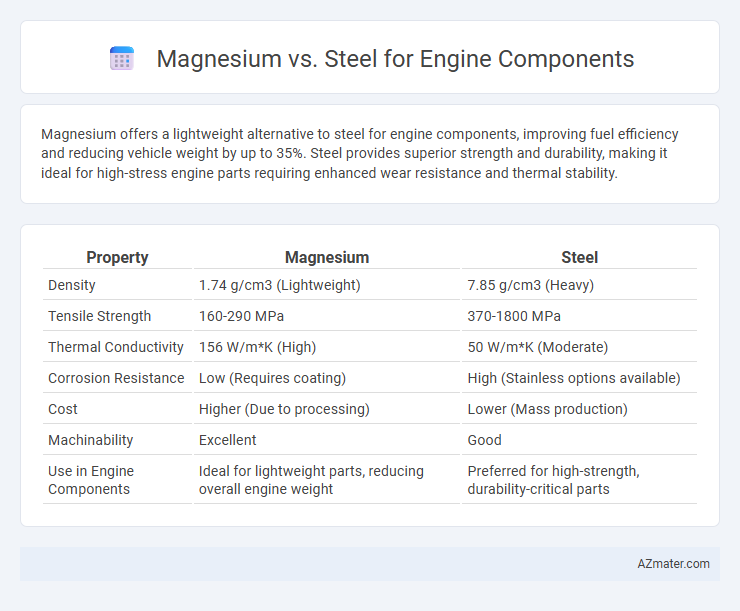Magnesium offers a lightweight alternative to steel for engine components, improving fuel efficiency and reducing vehicle weight by up to 35%. Steel provides superior strength and durability, making it ideal for high-stress engine parts requiring enhanced wear resistance and thermal stability.
Table of Comparison
| Property | Magnesium | Steel |
|---|---|---|
| Density | 1.74 g/cm3 (Lightweight) | 7.85 g/cm3 (Heavy) |
| Tensile Strength | 160-290 MPa | 370-1800 MPa |
| Thermal Conductivity | 156 W/m*K (High) | 50 W/m*K (Moderate) |
| Corrosion Resistance | Low (Requires coating) | High (Stainless options available) |
| Cost | Higher (Due to processing) | Lower (Mass production) |
| Machinability | Excellent | Good |
| Use in Engine Components | Ideal for lightweight parts, reducing overall engine weight | Preferred for high-strength, durability-critical parts |
Introduction: Magnesium vs Steel in Engine Components
Magnesium alloys offer significant weight reduction compared to steel, enhancing fuel efficiency and performance in engine components. Steel provides superior strength and durability, making it ideal for high-stress parts subject to extreme temperatures and mechanical loads. Choosing between magnesium and steel depends on balancing weight savings with mechanical reliability in automotive engine design.
Material Properties Overview: Magnesium and Steel
Magnesium offers a low density of about 1.74 g/cm3, providing significant weight reduction compared to steel's density of approximately 7.85 g/cm3, which enhances fuel efficiency and performance in engine components. Steel exhibits superior tensile strength ranging from 400 to 2,000 MPa depending on the alloy, and excellent fatigue resistance, making it ideal for high-stress engine parts. Magnesium's thermal conductivity around 156 W/m*K aids in heat dissipation, while its lower melting point near 650degC requires careful thermal management in engine applications.
Weight Comparison: Magnesium vs Steel
Magnesium alloys weigh approximately 35-45% less than steel, making them ideal for engine components where weight reduction directly improves fuel efficiency and performance. Steel exhibits a density around 7.85 g/cm3, whereas magnesium's density is about 1.8 g/cm3, offering a significant advantage in lightweight design. This weight difference enables magnesium components to reduce overall engine mass, enhancing acceleration and handling without compromising structural integrity.
Strength and Durability Analysis
Magnesium alloys provide a lightweight advantage but generally exhibit lower tensile strength and fatigue resistance compared to steel, impacting their durability in high-stress engine components. Steel alloys, particularly high-strength variants such as AISI 4140 or stainless steel grades, offer superior strength, wear resistance, and long-term durability under thermal and mechanical loads. However, advances in magnesium alloy development, including rare-earth element additions, aim to enhance their mechanical properties, making them viable for less critical engine parts where weight reduction is paramount.
Corrosion Resistance and Longevity
Magnesium alloys offer lightweight advantages but exhibit lower corrosion resistance compared to steel, often requiring protective coatings or treatments to enhance durability. Steel, especially stainless or treated variants, provides superior corrosion resistance and longer service life under harsh engine conditions. The choice between magnesium and steel for engine components hinges on balancing weight reduction with reliability in corrosive environments.
Manufacturing and Machining Considerations
Magnesium offers significant weight reduction in engine components, enhancing fuel efficiency, but requires specialized casting processes such as die casting and careful control of its flammability during manufacturing. Steel, known for its superior strength and durability, allows for versatile machining techniques including forging, milling, and turning, though it typically results in heavier components. Machining magnesium demands attention to chip control and spark prevention, whereas steel requires robust tooling and coolant management to handle its hardness and thermal conductivity.
Cost Effectiveness and Market Availability
Magnesium offers significant cost advantages over steel for engine components due to its lower density, reducing overall vehicle weight and improving fuel efficiency, which translates to long-term savings despite higher raw material prices. Steel remains more cost-effective in initial manufacturing because of its widespread availability, lower material cost, and established machining processes, making it a preferred choice for high-volume production. Market availability favors steel with extensive supply chains and recycling infrastructure, while magnesium's specialized production limits large-scale accessibility but is expanding with increased demand in automotive lightweighting.
Performance Impact on Engine Efficiency
Magnesium alloys, due to their significantly lower density compared to steel, reduce engine component weight, enhancing overall engine efficiency through improved power-to-weight ratio and fuel economy. Steel offers superior strength and durability, which supports higher load-bearing applications but increases component mass, potentially reducing efficiency. The choice between magnesium and steel directly impacts engine performance by balancing weight reduction benefits against structural integrity requirements essential for efficient engine operation.
Environmental and Recycling Aspects
Magnesium offers significant environmental advantages over steel for engine components due to its lower density, resulting in reduced vehicle weight and improved fuel efficiency, which decreases overall carbon emissions. Magnesium is highly recyclable, with recycled content retaining up to 90% of its original strength, and recycling magnesium consumes about 5% of the energy required to produce primary magnesium, making it an eco-friendly choice. Steel, while also recyclable with high recovery rates, typically requires more energy for recycling and processing, contributing to a larger environmental footprint compared to magnesium in engine manufacturing.
Application Suitability: Choosing the Right Material
Magnesium exhibits exceptional lightweight properties, making it ideal for engine components where weight reduction is critical for performance and fuel efficiency. Steel offers superior strength and durability, suited for high-stress engine parts exposed to extreme temperatures and mechanical loads. Selecting between magnesium and steel depends on balancing weight savings with structural integrity requirements specific to the engine component's function.

Infographic: Magnesium vs Steel for Engine Component
 azmater.com
azmater.com